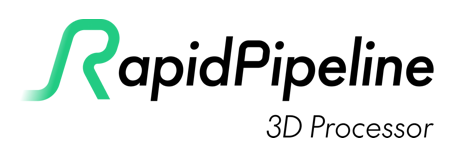3D Processing Settings

What are 3D Processing Settings?
RapidPipeline 3D Processing Configuration Settings adhere to the 3D Processing Schema and are designed to achieve any 3D processing goal. They operate directly on a 3D model and are able to alter the entire structure or re-create meshes, materials, UVs, texture maps and other 3D model properties.
See this reference for the 3D Processing Schema listing all available settings in context of which schema version supports them and what type each object and setting has within the schema.
Settings Categories and Guides
There are 7 major categories of 3D Processing Settings:
See the Settings Guides below, going through each of the main settings categories and all the features and 3d processing settings they contain.
Configuration Settings Files
Configuration settings files in .json format are the backbone of RapidPipeline's 3D Processor Technology. They are interoperable within all available interfaces and instruct the 3D Processor Core software on how to process or optimize a certain 3D model or scene.
A set of 3D processing configuration settings is also described as a 3D Processor Preset; for example within the RapidPipeline Web Platform.
Example
See below an example for such a Configuration Settings .json file:
{
"version": 1.4,
"meshCulling": {
"occlusionCulling": {
"perMesh": false,
"quality": "default",
"ignoreTransparency": false,
"diffusion": "none",
"runAfterDecimator": true,
"sampleEdges": true,
"perLumpDecision" : false,
"lumpThreshold": 0.6
}
},
"export": [
{
"fileName": "",
"textureMapFilePrefix": "",
"discard": {},
"format": {
"gltf": {
"pbrMaterial": {}
}
}
}
]
}
- The version indicates what Schema Version these settings relate to.
- The main objects called
mesh cullingandexportrepresent 2 of the 7 major categories of 3D Processing Settings. They contain more settings to fine tune the 3D processing behavior, but as you will see in the Settings Guide further below, they can contain other objects with their own settings as well. - Note that the
exportobject is a bit of an exception as it is usually always required within a configuration file, unless within the Integrations or if the--exportcommand is used within the RapidPipeline 3D Processor CLI.
In order to try out some example presets the 3D Processor Presets in the RapidPipeline Web Platform can be utilized.
To download a preset in editable JSON format, activate Preview New Settings with the radio button and download the respective settings JSON files via the Actions menu:

These JSON settings files can be ingested by the RapidPipeline Integrations (e.g. Blender Add-On) or the RapidPipeline 3D Processor CLI.
Learn more about how to ingest the JSON settings files with the 3D Processor CLI here.
3D Processing Schema
Introduction
RapidPipeline 3D Processor schemas are a set of rules that represent and validate the structure and format of RapidPipeline's 3D processing functionalities.
RapidPipeline maintains this semantic normalization by using schemas. Schemas are the standard way of describing data processes in RapidPipeline, allowing all data that conforms to schemas to be reused across all different tools and interfaces without conflicts.
In addition to describing the structure of data, schemas apply constraints and expectations to data so it can be validated as it moves between systems. These standard definitions allow data to be interpreted consistently, regardless of origin, and remove the need for translation across applications.
Available Versions and Compatibility
The 3D Processing Schemas are utilized by multiple RapidPipeline Software Packages & Interfaces as validation for JSON Settings files . Generally the most recent schema version will be adopted and applied within all interfaces.
Newer 3D Processing Schemas are only compatible with the corresponding newer 3D Processor CLI versions. Settings created against the newer schemas might not validate with older versions of the 3D Processor!
See the corresponding schemas and software releases below.
Web Platform
The RapidPipeline Platform and API are usually always on the latest Schema version.
3D Processor CLI
| CLI Version | 3D Processing Schema (link) | Description |
|---|---|---|
| v7.5.x | 3D Processing Schema v1.5 | Direct operations on the 3D Data, such as Optimization, Compression, etc. |
| v7.4.x | 3D Processing Schema v1.4 | Direct operations on the 3D Data, such as Optimization, Compression, etc. |
| v7.3.x | 3D Processing Schema v1.3 | Direct operations on the 3D Data, such as Optimization, Compression, etc. |
| v7.2.x | 3D Processing Schema v1.2 | Direct operations on the 3D Data, such as Optimization, Compression, etc. |
| v7.1.x | 3D Processing Schema v1.1 | Direct operations on the 3D Data, such as Optimization, Compression, etc. |
| v7.0.x | 3D Processing Schema v1.0 | Direct operations on the 3D Data, such as Optimization, Compression, etc. |
Integrations
| Integration & Version | 3D Processing Schema (link) | Remarks |
|---|---|---|
| All Integrations v1.1.x | 3D Processing Schema v1.5 | Supports RapidPipeline Actions, Within v1.0.x of the integrations only the Blender Add-On has access to the 3D Processor Settings now presented as Expert Mode |
| All Integrations v1.0.x | 3D Processing Schema v1.4 | Supports RapidPipeline Actions, Within v1.0.x of the integrations only the Blender Add-On has access to the 3D Processor Settings now presented as Expert Mode |
| Blender Add-On v0.2.4 | 3D Processing Schema v1.4 | Supports RapidPipeline Actions, 3D Processor Settings are now presented as Expert Mode |
| Blender Add-On v0.2.3 | 3D Processing Schema v1.3 | First experimental version of RapidPipeline Actions. Uses 3D Processing Settings validated against v1.3 schema. |
| Blender Add-On v0.2.2 | 3D Processing Schema v1.2 | Uses 3D Processing Settings validated against v1.2 schema. |
| Blender Add-On v0.2.1 | 3D Processing Schema v1.1 | Uses 3D Processing Settings validated against v1.1 schema. |
| Blender Add-On v0.2.0 | 3D Processing Schema v1.0 | Uses 3D Processing Settings validated against v1.0 schema. |
Further Documentation
For the full Documentation on all available data operations commands and system settings, please refer to the CLI Commands Guide and 3D Processor System Schema & Settings.
The 3D Processor is available for multiple interfaces: